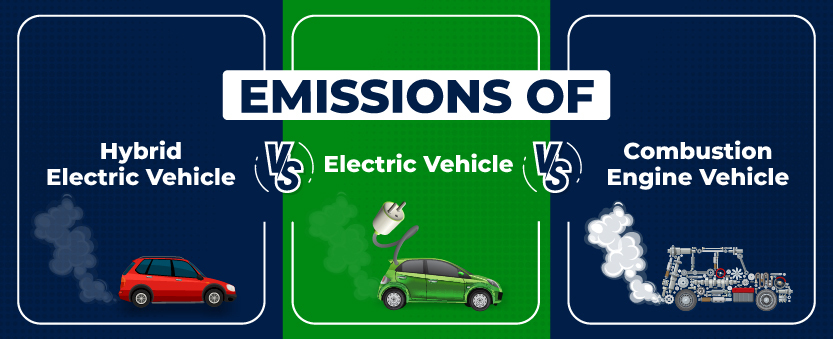
With all the efforts made worldwide to tackle climate change and reduce greenhouse gas emissions, the transportation sector has been in the spotlight due to its substantial environmental impact. That's where electric vehicles (EVs) & hybrid electric vehicles (HEV) come into play as promising solutions to help lower emissions. But to truly understand their environmental benefits, it's crucial to dig deeper and compare the lifecycle emissions of EVs to those of combustion engine vehicles (CEVs). That way, we can get a clearer picture of just how much of a positive impact EVs can have on our planet. Let us quickly read the difference between the emissions that EVs, HEVs & CEVs produce.
| Stages | EV | HEV | CEV |
|---|---|---|---|
| Battery Manufacturing | 5 (tCO2e) | 1 (tCO2e) | Nil |
| Vehicle Manufacturing | 9 (tCO2e) | 9 (tCO2e) | 10 (tCO2e) |
| Fuel & electricity production | 26 (tCO2e) | 12 (tCO2e) | 13 (tCO2e) |
| Tailpipe Emissions | Nil | 24 (tCO2e) | 32 (tCO2e) |
| Maintenance | 1 | 2 (tCO2e) | 2 (tCO2e) |
| Post-Consumer Emissions | 2 (tCO2e) | -1(tCO2e) | -1(tCO2e) |
| Total | 39 (tCO2e) | 47 (tCO2e) | 55 (tCO2e) |
Battery manufacturing in electric vehicles involves extracting and processing raw materials. Advancements in battery technology and sustainable mining practices continuously improve the environmental performance of battery production.
EVs, HEVs, and CEVs require energy-intensive processes during their manufacturing phase. However, CEVs with internal combustion engines tend to have higher emissions due to engine production's complexity and energy requirements. On the other hand, EVs & HEVs have simpler drive trains and emit fewer emissions during manufacturing, making them relatively more environmentally friendly.
Electric Vehicle & Hybrid Electric Vehicle produce 9 (tCO2e), when CEV produce 10 (tCO2e)
The energy source for vehicles is a critical factor in assessing their lifecycle emissions. CEVs depend on fossil fuels, which contribute significantly to greenhouse gas emissions. EVs rely on electricity, while HEVs combine electricity and fossil fuels. The environmental impact of EVs and HEVs during the operational phase depends on the carbon intensity of the electricity grid and the fuel efficiency of the internal combustion engine in HEVs.
Following are the use phase emission,
One of the most significant differences between EVs, HEVs, and CEVs is their operational emissions. HEVs are both electric & fuel; they produce lesser tailpipe emissions. CEVs emit more carbon dioxide and other pollutants directly from their tailpipes, contributing to air pollution and climate change. In contrast, EVs produce zero tailpipe emissions as they run on electricity. The environmental impact of EVs during the operational phase largely depends on the source of electricity generation.
We know that fully electric vehicle has zero tailpipe emission; Hybrid Electric Vehicle emits 24 (tCO2e) when CEV emits 32 (tCO2e)
CEVs often require more frequent servicing and repairs due to the complexity of internal combustion engines. EVs and HEVs, with simpler powertrain systems, generally have lower maintenance requirements, resulting in reduced emissions associated with vehicle servicing. Following are the emission under maintenance
EV = 1
HEV & CEV = 2 (tCO2e)
The end-of-life phase of vehicles also contributes to their lifecycle emissions. Proper disposal, recycling, and repurposing of vehicle components are crucial to minimize environmental impact. EV and HEV batteries can be recycled or repurposed, reducing waste and emissions. CEVs typically have more complex components that require careful handling and recycling. Following are the Post-Consumer Emissions
EV = -2 (tCO2e)
HEV = -1 (tCO2e)
CEV = -1 (tCO2e)
In total,
EV emits 39 (tCO2e)
HEV emits 47 (tCO2e)
CEV emits 55 (tCO2e)
Assessing the lifecycle emissions of EVs, HEVs, and CEVs reveals several advantages of electric vehicles regarding environmental impact. EVs exhibit lower emissions during battery and vehicle manufacturing, produce zero tailpipe emissions, and generally require less maintenance. However, it is crucial to acknowledge that the overall environmental benefits of EVs depend on the source of electricity generation. Transitioning to renewable energy sources for electricity production is essential to maximize the positive impact of EVs on reducing greenhouse gas emissions and combating climate change.
As technology advances and renewable energy adoption grows, electric vehicles have the potential to play a significant role in creating a sustainable transportation sector. Governments, industries, and individuals must continue investing in renewable energy infrastructure and supporting the widespread adoption of EVs to drive the transition towards a cleaner and greener future.
CEV - Combustion Engine Vehicle
EV - Electric Vehicle
HEV - Hybrid Electric Vehicle
tCO2e - tonnes (t) of carbon dioxide (CO2) equivalent (e)